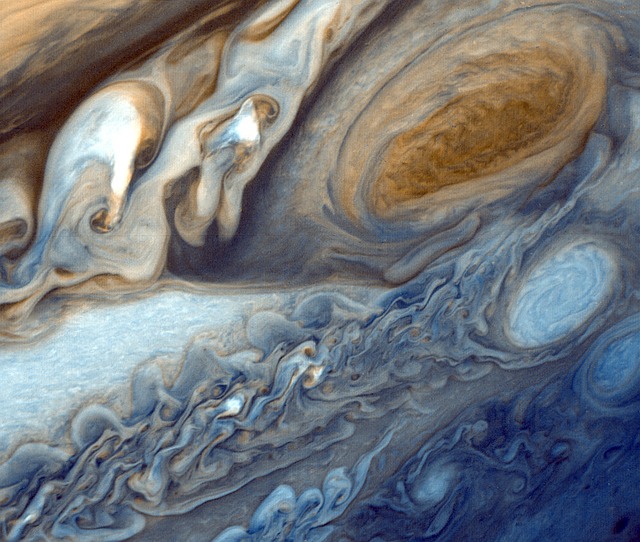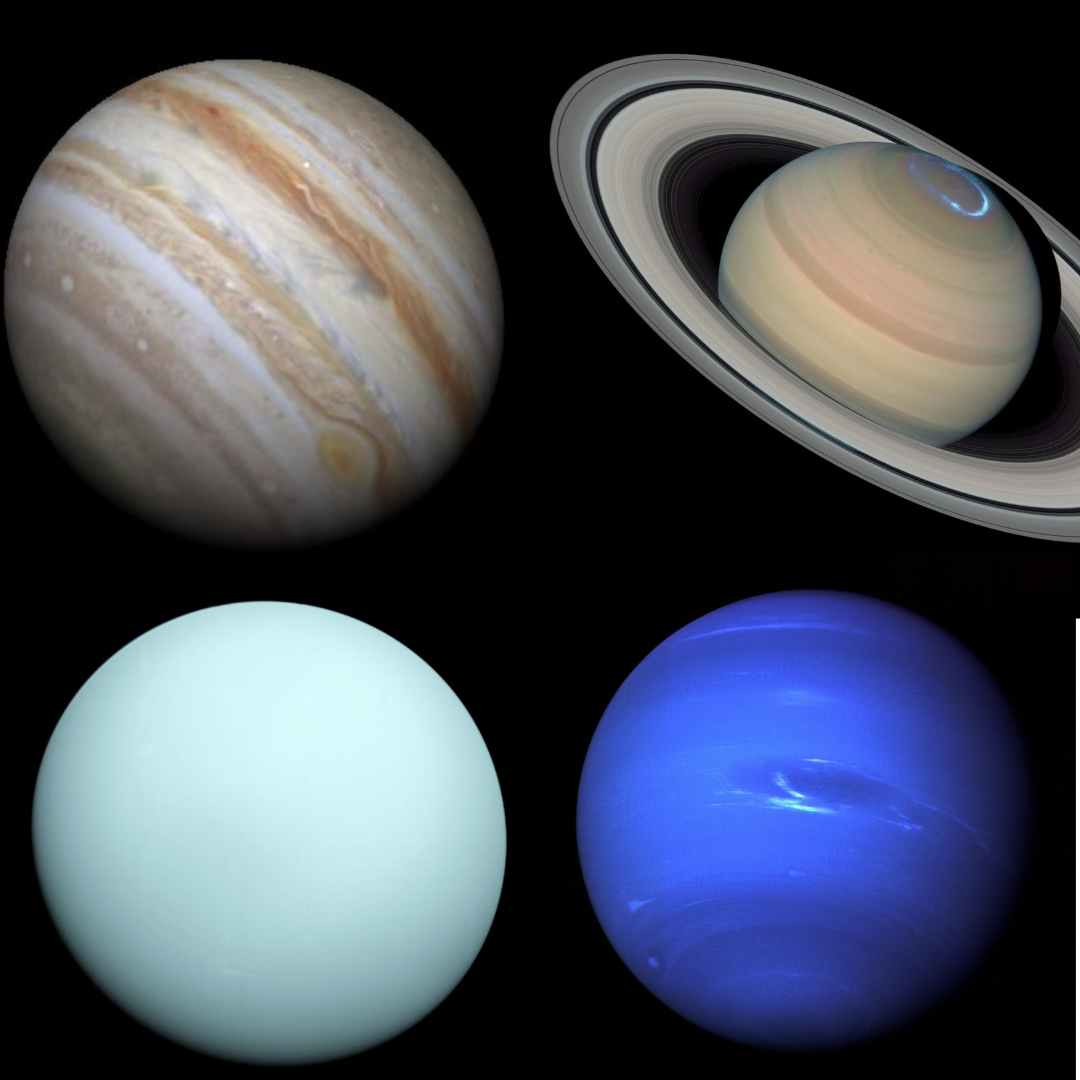*This post may contain affiliate links. This means we may make a commission if you purchase an item using one of our links*
Jovian planets are predominantly composed of hydrogen (80-90%) and helium (10-20%), with small, dense cores relative to massive layers of atmospheric gas. They contain small amounts of methane, ammonia and water vapor with varying traces of heavier elements such as carbon, oxygen, sulfur and phosphorus.
Jupiter, Saturn, Uranus and Neptune are our solar system’s jovian planets, in contrast to the terrestrial planets (Mercury, Venus, Earth, Mars).
Jovian planets have a number of interesting visible characteristics which are related to their chemical constituents, including Neptune’s blue color, Jupiter’s red spots, and Saturn’s bright rings. This article tells you more about the main constituents of jovian planets in general as well as some specific information on particular elements and compounds found in individual planets.
What Are Jovian Planets?
Table of Contents
The Jovian planets are the four largest planets in our solar system, often referred to as “gas giants”. The word “jovian” derives from an alternative name for Jupiter, the leading god of the classical Roman pantheon, after whom the planet Jupiter is named.
As well as gaseous composition, the jovian planets are characterized by their massive size (Jupiter is around 11 times as big as Earth) and a correspondingly large gravitational pull which allows them to hold many moons in their orbits, as well as orbiting rings of dust, debris and ice.
The jovian planets are those furthest from the Sun, lying beyond the “frost line” in our solar system, a point around 750 million km from the Sun beyond which water generally remains solid ice, even in direct sunlight.
Atmospheric Composition On Jovian Planets
Hydrogen And Helium
Jovian planets are predominantly composed of hydrogen and helium, two of the lightest chemical elements. This mirrors the original solar nebula which likely spawned our solar system.
Strong gravitational forces (caused by size) and low temperatures (resulting from distance from the sun) have enabled the jovian planets to retain the ‘primary atmosphere’ they acquired as they formed.
Terrestrial planets would originally have had the same kind of primary atmosphere as jovian planets. This has long been replaced in most cases by a secondary atmosphere formed from volcanic activity and comet impacts.
Weaker gravity, higher temperatures resulting from closer proximity to the sun, and low molecular weight of hydrogen and helium, all made it much easier for the hydrogen and helium-rich primary atmosphere to escape from terrestrial planets. (NB High temperature and solar winds mean that Mercury lacks a secondary atmosphere too.)
Methane, Ammonia And Water Vapor
Helium is inert (chemically un-reactive under normal circumstances) which means that atmospheric chemistry on jovian planets is dominated by hydrogen. In line with this fact, we may find hydrogen compounds of carbon, oxygen, nitrogen, phosphorus and sulfur in the bulk atmosphere of the jovian planets. Methane, ammonia and water vapor are all common in varying proportions.
Individual Jovian Planet Atmosphere Characteristics
Jupiter: Jupiter’s atmosphere is 90% hydrogen by volume and almost 10% helium. The remaining fraction consists of small amounts of ammonia, methane, phosphorus, sulfur and water vapor.
There are three cloud layers in Jupiter’s atmosphere. The outermost layer is probably ammonia ice, with a middle layer likely to be ammonium hydrosulfide crystals, and an inner layer of water ice and vapor.
Viewed from space, Jupiter has a distinctive appearance with both spots and colorful bands of cloud. The colored cloud bands may be gaseous plumes of sulfur and phosphorus compounds rising up from warmer regions closer to the planet’s core.
Their patterns may be linked to Jupiter’s fast rotation (every 10 hours) which causes strong jet streams, splitting the colored clouds into dark and light areas.
Jupiter’s massive gaseous atmosphere gives rise to powerful storms which can rage long and hard without any solid surface to absorb or deflect their energy, The spots visible on Jupiter’s surface are actually huge storms and the Great Red Spot – twice the diameter of Earth – has been observed through telescopes for over 300 years.
The Little Red Spot is a smaller and more recent storm formation.
Saturn: Saturn has a very similar atmosphere to Jupiter with 18-25% helium, 75-82% hydrogen and trace amounts of methane and ammonia. Like Jupiter, Saturn also has clouds of ammonia ice crystals.
While Saturn’s surface may appear less colorful than Jupiter’s, its rings are partly formed from chunks of ice, which reflects sunlight and makes them more visible than the dust particle rings of Jupiter, Neptune or Uranus.
Neptune: By volume Neptune’s atmosphere is composed of molecular hydrogen (80%), helium (19%), methane (1.5%), hydrogen deuteride (192 parts per million) and ethane (1.5 parts per million).
Methane gives Neptune its blue tint, as it absorbs red light and reflects blue light. Traces of iced ammonia, water, ethyne and ammonia hydrosulfide are also found in Neptune’s atmosphere.
Uranus: The atmosphere of Uranus is around 83% hydrogen, 15% helium and 2% methane with traces of ethyne and other hydrocarbons. Uranus is a duller shade of blue than Neptune with other atmospheric compounds as well as methane influencing its color.
Neptune and Uranus both have higher concentrations of methane and heavier elements (oxygen, carbon, nitrogen, phosphorus, sulfur) than Jupiter and Saturn.
NB As the two outermost planets in our solar system Neptune and Uranus are the most difficult to study. Only one space mission, Voyager 2, has flown by and collected data at close quarters.
This means that hypotheses such as the existence of diamond rain on Neptune remain interesting but unsubstantiated…
What Are The Constituents Of Jovian Planet Surfaces?

Jovian planets lack a solid surface as found on terrestrial planets. Instead, their constituent gases grow denser as they approach the core, eventually becoming liquid, and then a kind of metal around their core.
For the purposes of defining and comparing planetary temperature, air pressure etc.. scientists set the “surface” of jovian planets as being the region where atmospheric pressure exceeds one bar (i.e. the pressure at sea level on Earth).
The constituents of a jovian planetary surface will therefore simply be those found in the atmospheric region where pressure passes one bar.
What Forms The Core Of Jovian Planets?
Jupiter and Saturn are believed to have a dense rocky core covered by a thick layer of metallic hydrogen, with another layer of molecular hydrogen above this. The cores of Uranus and Neptune are also thought to be composed of rock and metal, combined with water, methane and ammonia, and covered with a layer of gaseous hydrogen.
Summary
The constituent elements of jovian planets can help explain distinctive colors, patterns and other visible characteristics. Jovian planets are predominantly formed from hydrogen and helium, largely retaining their original primary atmosphere.
Helium is un-reactive so most compounds found in the jovian planets are hydrogen based. Methane, ammonia and water vapor are common as trace compounds, with hydrocarbon compounds and heavier elements also found in some cases.
References
https://lasp.colorado.edu/outerplanets/giantplanets_whatandwhere.php
https://lasp.colorado.edu/outerplanets/giantplanets_interiors.php
https://astronomy.swin.edu.au/cosmos/J/Jovian+Planet
https://www.nasa.gov/sites/default/files/atoms/files/04-solar-system-the-jovian-planets.pdf
https://www.space.com/18922-neptune-atmosphere.html
https://www.space.com/18385-jupiter-atmosphere.html
https://www.weather.gov/fsd/saturn
https://www.esa.int/Science_Exploration/Space_Science/Cassini-Huygens/Saturn_s_atmosphere
https://sos.noaa.gov/catalog/datasets/jupiter-two-red-spots-2007/
https://www.americanscientist.org/article/on-neptune-its-raining-diamonds
https://solarsystem.nasa.gov/missions/cassini/science/rings/

